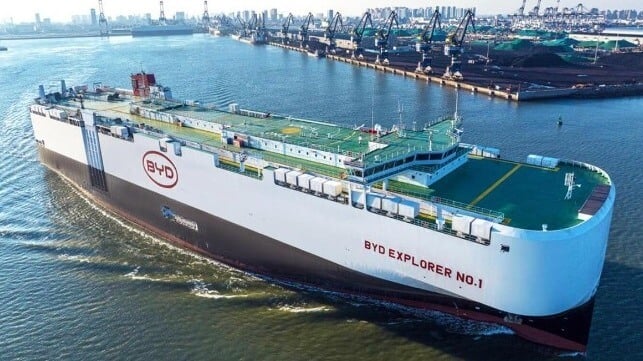Top Electric-Car Builder BYD Sends its First Ro/Ro to Europe

In a tight market for ro/ro capacity, China's thriving auto exporters are building or chartering their own vessels to ensure enough space to deliver to markets overseas - especially Europe.
Last week, leading electric car manufacturer BYD unveiled its first chartered-in PCTC, the BYD Explorer No. 1. Built by CIMC Raffles, owned by Japan's Taihei Kaiun, and operated by London-based Zodiac Maritime, the new ship is LNG dual-fuel powered and can carry up to 7,000 cars at a time. It is the first of seven newbuilds scheduled to join BYD's fleet within the next two years.
After a pierside commissioning ceremony, BYD Explorer departed Shenzhen on January 15, carrying a full load of vehicles for customers in Europe.
Dedicated tonnage will provide BYD with certainty for its export sales commitments. In a hot market for PCTCs - Clarksons estimated the one-year charter rate at about $115,000 per day as of November - the multi-ship procurement program might also save BYD on cost. The vessels will also serve other automakers when space is available, BYD said.
Not to be outdone, domestic competitor Chery has acquired its own shipyard to build its own ro/ro fleet. The "Chery Wuhu Shipyard Weihai Green Marine Technology Industrial Base" will churn out 6,000-car ro/ros and 80,000 dwt Panamax bulkers for Chery and other clients.
China's shipping heavyweights are also investing in ro/ro tonnage. China COSCO, the largest shipowner in the world by tonnage, has ordered 24 LNG-fueled PCTCs, which will make a substantial market impact when they begin to deliver in the middle of this year.
Stackable, container-like racks for bulker transport are also increasingly popular as a ro/ro alternative, according to Chinese outlet The Paper. COSCO Shipping has worked out a rack system designed to fit into its pulp carriers for transit to South America. The racks can be loaded on board using a standard container spreader. At the other end, the bulker is backloaded with a cargo of pulp, so it can sail laden and generate revenue in both directions. About 100,000 cars a year depart Taicang Port in these racks, according to the outlet.
